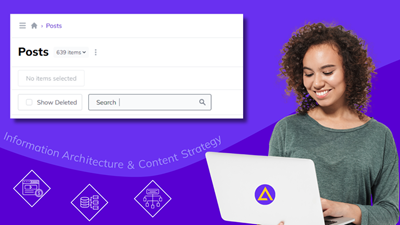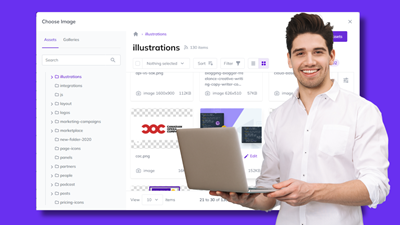The Importance of Future-Proofing Your Content

In today's digital landscape, creating and sharing high-quality content is critical. However, producing valuable content (worth seeing) that resonates with your target audience is not enough. To ensure that your content delivers value over time, you need to future-proof it.
To put it simply, your content is like a house that is created to survive anticipated stresses such as cyclones and earthquakes in the future. This means creating content that is adaptable, and flexible enough to enter any new medium of consumption.
In this blog, we will explore how you can future-proof your content today!
What does future-proofing your content mean?
"Future-proofing" refers to taking steps to ensure that something remains relevant and useful in the future. It means creating content in a way in which the topic of the content is not going to be obsolete in the future.
To future-proof your content, understanding content modeling is important in setting up your content for reusability.
The core of this strategy is to focus on evergreen content, producing timeless content that isn't tied to a specific time or event.
Importance of future-proofing your content
Why is future-proofing important? It's about making sure that the content you put out stays relevant in SERP and to your brand's values for a sustained period of time.
Increased Content longevity
Evaluate and consider your brand’s mission statement today. This is to make sure that the content you create today will be representative of your brand values in five years. Once this is thought through, create content that is less about the trends of the day and more on foundational elements on which your brand wants to focus.
Improved search engine rankings
Better user experience
Creating content that is evergreen and remains relevant can help improve the user experience on your website. Your customers will appreciate having access to high-quality content that helps them solve their problems.
Cost-effectiveness
By future-proofing your content, you can avoid the need to constantly create new content, which can be expensive and time-consuming. Instead, you can focus on updating and repurposing existing content to keep it fresh and relevant.
7 Ways to future-proof your Content
When push comes to shove, companies go through massive digital transformation. Many brands are already merging the physical and digital worlds to produce future-proof content.
Still, there are many ways to futureproof your content:
Focus on evergreen topics:
Create content that is not time-sensitive and is relevant and valuable to your audience over time. Evergreen topics include “How To” Guides, listicles, FAQs, and expert tips and suggestions. For example, Guides on “How to plant a seed” or “How to build a wooden box,” probably won’t change over the next 50 years
Use data-driven insights:
Use analytics and data to identify the topics that are resonating with your audience and focus on creating more of that content. For example, you can conduct keyword research to identify the terms and phrases that your target audience is using to search for information related to your products. Don’t forget to use tools like Google AdWords or SEMrush to conduct keyword research and identify relevant search terms that you can target with your content.
Anticipate trends:
Research from Zazzle Media reveals that 60% of people find it hard to produce content consistently.
Leverage multimedia formats:
It doesn’t matter what type of content you create whether it's videos, podcasts, or infographics content, don’t forget to connect with your audience. Try to create content that helps you build trust in real time.
Make it easy to update:
Structured content is always easy to update. Make sure you have a system in place for monitoring your content and updating it as necessary. Use a content management system that makes it easy to update content by providing a user-friendly interface for making changes.
Get Digital:
Personalized e-commerce content is crucial for future-state content strategies. As per stats, the number of digital buyers worldwide has nearly doubled to 2.1B from 2014 to 2020. The current digital environment has only increased that growth, driving online sales through the roof. When considering the home for your futureproof content, think about the experience first. Is it engaging? educational? Does it offer options for users to personalize their experience? Since people enjoy mapping out their own paths, the same goes for content consumption habits even in the future.
What are future-proofing strategies?
Future-proofing strategies are proactive measures that organizations take to prepare for and adapt to future changes in their industry or market. These strategies help organizations to anticipate and prepare for future challenges, trends, and disruptions, and ensure their long-term success. Brands are using future-proofing strategies to prepare for and adapt to the changes and challenges that lie ahead. On that note, here are some common future-proofing strategies:
Develop a flexible business model:
Build flexibility into your business model to adapt to changing market conditions and customer needs. This may involve developing a range of products or services that can be easily adapted or reconfigured to meet changing demands. Diversifying your revenue streams and building a recession-proof culture is also a part of future-proofing.
Customer-focused approach:
Prioritize the customer experience and create products and services that are designed to meet the changing needs of your customers. For example, incorporating customer feedback in your content strategy can improve your brand's loyalty and customer satisfaction rate also.
Invest in talent development:
Invest in your talent pool. Ensure that your employees have the necessary skills and knowledge to adapt to changing market conditions. Provide them with the necessary support, tools, and resources to complete their task. They should be familiar with the new tools and strategies that are in the market.
Monitor trends and disruptions:
It’s better to stay ahead of market changes and anticipate and respond to future trends rather than stay behind. Monitor trends and disruptions in your industry and develop contingency plans to address potential challenges. For example, Companies like Uber have a strong foothold in their market. But they can easily see themselves defeated by new technology. Imagine Google and Tesla perfect the self-driving car, Uber should get done before they’re able to build their own prototype. The same goes for traditional auto companies. This implies monitoring digital trends is one of the most critical tasks for a business if it wants to stay relevant.
Foster a culture of innovation:
Communicate, create an innovation sandbox, and be open to new ideas within your organization. Predicting the future is not a cakewalk. The best way to future-proof your business is by encouraging creativity, experimentation, and risk-taking. Send your employees to future events, and tech conferences for discovering solutions to future problems and reward them for their work.
Future-Proofing for Continued Success
As technology leaps and bounds ahead, creating future-proof content is a smart step to make your brand consistent.
Future-proofing your content is as sound as a dollar. By creating content that remains important and valuable to your audience over time, focusing on evergreen topics, using data-driven insights, and anticipating trends, you can ensure the longevity of your content.
Use above mentioned future-proofing strategies, run a small test first, and then invest in experts who can help you create smart content. Moving to future content can be a big step for your organization depending on the size of your company.
So, take one step at a time, and don’t forget to deliver value to your audience.


